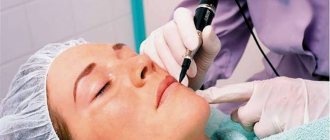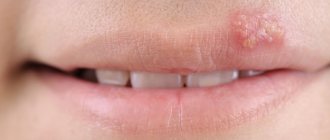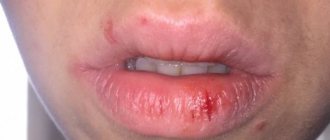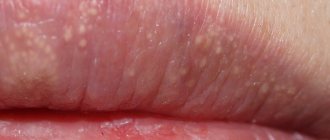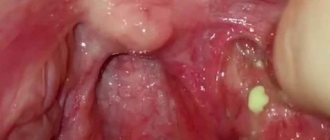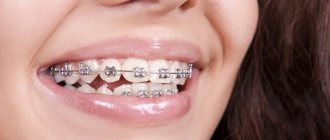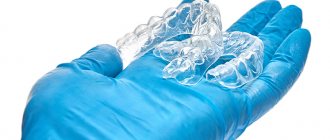The remedy for Fordyce granules is an effective treatment option for neoplasms that appear on the skin of the human body. The phenomenon of seborrheic cysts is quite common, and for the most part does not cause concern among its owners. Nevertheless, for some people they become an acute problem, and all possible methods are selected to get rid of this phenomenon. Patients are looking for a method that will help get rid of Fordyce granules without causing harm to health.
Features of Fordyce granules
Fordyce granules look like small compactions - nodules, the size of which does not exceed 2 millimeters and a height of 1 millimeter. They have a light, flesh-colored or white color. They are located mainly in groups of several dozen specimens. Formations can be seen on the nipples of women, in the genital and anal areas, in the armpits and on the face. This anomaly affects about 35% of people, mostly women. When such a granule is squeezed, a curd mass may come out of it, white or yellow in color with a specific odor.
The presence of granules is almost unnoticeable. They do not cause pain, and the discomfort of their presence is completely eliminated.
Many experts consider such neoplasms to be an absolutely normal phenomenon. The reasons for their occurrence are associated with the abnormal location of the sebaceous glands, which is considered completely acceptable or normal.
The growths do not cause physical discomfort to a person. The desire to get rid of granules is associated with psychological discomfort due to the ugliness of the skin. The formations are not prone to complications, transmission to another person is excluded.
The appearance of granules can occur due to:
- stress;
- poor nutrition;
- bad habits;
- environmental impact.
The appearance of granules is observed during the period of hormonal changes in the body. Vulnerable periods are puberty and pregnancy. Often the granules dissolve on their own, without any intervention.
Fordyce granules
Fordyce granules: why they occur and how to get rid of them
For some this is an almost unnoticeable trifle, but for others it is a serious cosmetic defect. What are Fordyce granules and can they be treated? What do cosmetologists and dermatologists offer to patients who come to them with such a problem?
WHAT ARE FORDYCE GRANULES
Fordyce granules (or Fordyce disease) are light-colored pimples (sebaceous glands) that can form on the oral mucosa, cheeks, lips, female labia, surface of the male penis, breast nipples, groin area and other places on the body Currently, Fordyce granules are considered normal, but in some cases they can cause severe discomfort. Fordyce granules are also called seborrheic cysts.
According to medical statistics, Fordyce disease affects 35% of women and 60% of men. The granules do not lead to the development of complications, do not cause harm to health, and are not transmitted to a partner during sexual intercourse. Most often, patients with seborrheic cysts seek medical help because of a cosmetic defect, since these neoplasms do not cause any other complications.
FORDYCE GRANULES: REASONS
The reasons for the appearance of Fordyce granules are still unclear. Despite the name "seborrheic cysts", no connection with seborrhea has been found in Fordyce granules. Most often, these neoplasms occur during puberty, when hormonal changes in the body give rise to the appearance of sebaceous gland cysts.
The current prevailing view is that the main cause of Fordyce granules is that in some people the sebaceous glands are located too close to the upper layer of the dermis and epidermis. In some cases, they are located abnormally - on the border of the lips or on the mucous membrane of the mouth.
It is noteworthy that this arrangement of the sebaceous glands is congenital in nature, however, during puberty (13-16 years), under the influence of sex hormones (in particular, male sex hormones), the activity of the sebaceous glands increases. In adolescence, the level of sebum production increases, which leads to the noticeable appearance of sebaceous gland granules.
Doctors identify several factors that contribute to the appearance of granules, including:
- smoking;
- damage to the ducts of the sebaceous glands;
- neglect of hygiene rules;
- hormonal imbalances;
- narrowing of the excretory ducts of the sebaceous glands.
It is noteworthy that Fordyce granules can be present in a person for many years, but after 40 years, seborrheic cysts can disappear on their own.
Fordyce granules
FORDYCE GRANULES ON THE LIPS
Unlike Fordyce granules on other parts of the body, seborrheic cysts on the lips are smaller (diameter does not exceed 2 millimeters) and less convex. They are white or pale yellow in color. For some people, the granules cause itching, but you should not scratch them, as this can lead to infection. In this case, it would be best to consult a doctor so that a specialist can prescribe antipruritic medications.
In addition, do not try to squeeze out the nodules under any circumstances. Firstly, this will not get rid of the rash, but on the other hand, when you try to squeeze out the nodule, a hematoma will form due to minor bleeding. In this case, scars may remain, which in an aesthetic sense is much worse than Fordyce granules.
FORDYCE GRANULES: TYPES
There are two types of Fordyce granules:
- Fox-Fordyce disease
- Pearly penile papules
As for pearly penile papules, this is a variant of the norm . According to medical research, they occur in 30% of young men . They do not cause any harm to health, and are not sexually transmitted and do not cause any complications, so the man and his sexual partners have nothing to worry about.
In medicine, the problem of pearly papules has been poorly studied, and doctors do not have sufficient awareness of this phenomenon. There is no effective treatment for pearlescent papules yet, but it is not required.
The reason for the appearance of pearly papules on the penis is also still unclear. Some experts believe that the whole problem comes down to excessive proliferation of the epithelium of the excretory ducts of the glands of the penis. Other doctors are inclined to believe that the reason for the appearance of pearly papules is fibroplastic proliferation of areas of the epithelium of the glans penis.
As a rule, pearly penile papules appear during puberty, when the level of male sex hormones in the blood increases. It is noteworthy that among peoples who practice circumcision, the incidence of pearly papules is significantly lower than among others. It is believed that this is due to the fact that the increased amount of secretions and smegma with a circumcised penis is more easily released during hygiene measures.
As for Fox-Fordyce disease, it is an analogue of pearly papules, but only in women. The clinical manifestations of Fox-Fordyce disease are the same as those of pearly penile papules. This lesion is localized in the apocrine sweat glands and is to some extent associated with urinary function. It is possible that Fox-Fordyce disease is of endocrine origin.
Localization of granules in Fox-Fordyce disease is on the pubis, axillary fossae, perineum, labia majora, and around the nipples. As a rule, Fox-Fordyce disease is manifested by moderate skin itching, which intensifies during menstruation. Fox-Fordyce disease lasts for years and often goes away on its own after age 40.
DIAGNOSTICS OF FORDYCE GRANULES
When examining a patient, the picture of the rash is quite typical, and only on the basis of examination can the doctor make a diagnosis. However, if there are too many rashes, then there is a danger of confusing them with other diseases. In particular, when conducting diagnostics, it is important to differentiate Fordyce granules from eczema, lichen planus, neurodermatitis and molluscum contagiosum. In this regard, during the examination, the doctor may take a smear or prescribe a biopsy for microscopic examination of the sample taken.
FORDYCE GRANULES: TREATMENT
There are currently no effective treatments for Fordyce granules. It is impossible to completely get rid of such rashes. At the same time, doctors offer their patients some alternative techniques that can slightly improve the cosmetic effect. In particular, patients are offered jojoba oil, as well as laser nodule removal procedures. It is difficult to talk about the effectiveness of these procedures, since the effect is different for different patients (but not high).
It is noted that with regular use of the products it is possible to prevent the appearance of new Fordyce granules. Removing granules using laser, cosmetic surgery or cryotherapy may only be effective for a while, as the granules reappear after some time. Effective methods for the prevention of Fordyce granules have also not yet been developed.
Each organism has its own characteristics and even the most harmless intervention can manifest them. One of these manifestations is Fordyce granules, and patients often find out about them only after the procedure.
Fordyce granules
Anamnesis
The patient came in for lip augmentation. This was her second procedure. The previous one was carried out three months ago by another specialist and, according to the girl, did not lead to the expected result.
Lip augmentation was performed with hyaluronic acid and went without complications.
Complementary therapy
To reduce swelling and prevent the appearance of hematomas, a homeopathic medicine was prescribed, 5 granules 4 times a day, several days before and after the procedure.
Complaints
10 days after the modeling, the patient began to complain of “yellowish dots in the upper lip area.”
Since telephone consultation is not acceptable, the patient was asked to attend an appointment. The girl ignored the advice and decided to go straight to a dermatologist.
Consultation with a dermatologist. Diagnosis
The dermatologist diagnosed an “allergic reaction to the filler” and prescribed treatment in the form of surgical removal of the papules “one at a time.”
It is important to know that an allergic reaction to hyaluronic acid occurs on the first day after administration of the drug.
It appears:
- inflammation
- severe swelling
- redness
- increase in temperature in the injection area and/or the whole body
Diagnosis by an esthetician
In fact, the patient’s complaint is related to the physiological state of her lips. The girl has a skin defect called Fordyce granules. After the filler was injected into the lips, features (granules) that were previously insignificant also increased.
Fordyce granules are painless skin formations, seborrheic cysts, which are small papules with white-yellow contents of a dense consistency.
This skin feature does not cause any harm to health and is only a cosmetic defect.
There is no specific treatment. Therapeutic treatment does not bring the expected result. They offer cryotherapy, electrocoagulation and laser therapy.
There is no prevention, since seborrheic cysts are not considered a disease, but are a variant of the norm.
Source: likar.info, estet-portal.com
Medical scientific and practical journal “Science & Medicine”
Types of treatments
Treatment is not a necessary measure in this matter. Nevertheless, for many people it becomes relevant, as it causes many complexes about the appearance of the body.
Ointments
The most popular remedy for combating Fordyce's disease is Retin A ointment. The drug affects the secretion of the sebaceous glands and dissolves the formations that have arisen. Trans-retinoic acid, which is part of the ointment, neutralizes the contents of sebaceous plugs and regenerates skin tissue. You need to apply the cream once a day, preferably in the evening, before bed. It is important to avoid contact of the substance with the eyes and mucous membranes of the body. After 6 hours, it must be washed off with running water. The first effects are observed after 2-3 weeks. The full course of treatment lasts up to 2 months. Analogs of the cream drug Airol and Lokacid.
Removal by devices
New growths can be removed by performing an instrument procedure. Modern medicine offers many options for removing skin defects in a hospital setting:
- Cryodestruction - granules are frozen with liquid nitrogen. A special device is applied to the affected area for a few seconds. After this, the growth begins to collapse and dies.
- Laser removal is the most popular. It occurs under the influence of a special laser beam, which burns out the growth layer by layer. Removing Fordyce granules with this laser takes several minutes.
- Electrocoagulation – neutralization of the cyst occurs using high frequency electric current. The current energy accumulates in the tip, after which it evaporates the liquid from the tissues of the growth. Thanks to the method, elimination takes place without blood loss.
- The radio wave method is the most gentle. Excision is carried out by exposure to high-frequency waves that cut off the formation. Moreover, at this moment there is no contact between the device and the tissues.
We recommend reading:
- How to get rid of warts on the neck
- Is it possible to cauterize condylomas?
- Features of the appearance of a wen on the scrotum
Medications
Treatment of cysts is carried out without the use of various medications. In special cases, your doctor may recommend taking anti-inflammatory drugs or antibiotics to prevent bacterial infection. The selection of medications is solely at the discretion of the doctor, depending on the symptoms of the disease and the characteristics of the patient.
Removing Fordyce Granules
Reasons for appearance
Fordyce granules can appear in completely healthy people, but are more often found in those who have a number of predisposing factors such as:
- Seborrhea, oily skin;
- Puberty;
- Increased production of male sex hormones in women;
- Metabolic disorders (high cholesterol, liver disease).
Favorite localization in the area of the labia minora and majora in women, on the penis and scrotum in men, in the transition zone of the oral mucosa and lips. In this area, the skin is thin and contains virtually no subcutaneous fat, so the enlarged sebaceous glands are clearly visible and palpable.
Symptoms
Fordyce granules do not cause any discomfort to those who develop them. There is no pain when touching, having sexual intercourse, or eating food. The patient accidentally discovers a rash and this becomes the reason for visiting a doctor. It is not the aesthetic appearance that makes you see a doctor.
The size of the enlarged sebaceous glands can change, decrease, increase, or unite, thereby changing the appearance.
Diagnostics
To make a diagnosis, a visual examination by a specialist is sufficient. Additionally, it may be recommended to take tests for:
- Total cholesterol (lipid profile);
- Total testosterone, androstinone;
- Basic biochemical parameters (ALT, AST, bilirubin, creatinine).
To prevent the appearance of new rashes when a metabolic disorder is detected, a correction is prescribed.
Removing Fordyce Granules
Several techniques are used to remove enlarged sebaceous glands:
- Electrocoagulation (exposure to electric current causes local burning of tissue);
- Laser removal (laser beam entering the surface layers of the dermis causes evaporation and destruction of tissue);
- Radio wave therapy (radio waves, when touching tissues, cause point coagulation).
The priority method is surgical laser, as it has a number of advantages:
- During removal, the surrounding tissues are not damaged, the laser precisely affects the lesion;
- After removal, it does not leave marks on the skin and mucous membranes, which is important when working on the face and intimate area;
- A shorter period of tissue regeneration, the healing period is 3-7 days shorter than with other methods of exposure;
- Non-contact influence.
Care after removal
- For the first 24 hours, do not wet the area affected by the laser beam;
- Protect the resulting crusts and do not tear them off; they will fall off on their own after 7 days;
- Avoid baths, saunas, and swimming pools for 14 days;
- If the removal was in the intimate area, underwear can be worn only from cotton fabrics, loose, so as not to rub the skin.
How does a cosmetologist remove it?
In addition to standard clinical treatment methods, a person with rashes can be treated at home, or seek the help of a cosmetologist.
After a diagnostic examination, the cosmetologist can select one of the most suitable methods. Most often, for such a problem, treatment with the Darsonval apparatus is used or permanent makeup is applied.
The use of Darsonval allows you to cleanse the skin, saturate it with oxygen and restore natural metabolic processes in tissues. The sebaceous department is normalized. The skin becomes more pleasant and smooth to the touch. In this case, the course of treatment will be about 10 sessions. During the procedure, the specialist installs the necessary attachment – an electrode – into the device holder. After this, light movements massage the skin. Unfortunately, cosmetologists do not give a 100% guarantee of an effective outcome. A similar procedure can also be carried out at home.
Permanent makeup is used for minor tissue damage. Especially if the growths are on the lips. To do this, a special pigment is introduced into the required area, which colors the granules that stand out in color. Tissue tattooing takes place. The result of the procedure lasts for 1-2 years, after which the event must be repeated.
Fordyce granules. What is this?
Many people have them, almost everyone, but rarely does anyone notice these granules on their face until…. until we had lip contouring done!
What a strange name?
Fordyce granules or otherwise called seborrheic cysts are sebaceous glands on the skin. Their strange name comes from the name of the scientist JA Fordyce who described these cysts back in 1896.
What are these Fordyce granules?
Fordyce granules look like small (1-2 mm) spots and papules (small nodules) of white or yellowish color. They are painless and numerous. These are sebaceous glands, which in some people are located ectopically (closer than normal to the upper layer of the epidermis). Locations: in the lip area, on the border of the lips, on the mucous membrane of the mouth, on the nipples, in the groin, on the labia.
Fordyce granules - are they dangerous?...
No. They do not cause harm to human health. They are not transmitted through any type of contact (including sexual contact). They are considered a type of NORM.
Why do you need to know about Fordyce granules?
I decided to write about these granules because when performing lip contouring I often come across the fact that the client did NOT notice them on herself until her lips were “done.” During the procedure, the volume of the lips is filled and some tension of the skin occurs, during which the granules become more clearly visible. In addition, the desire to consider the result of the procedure forces the client to more carefully and thoroughly examine her lips in great detail..... And then panic begins and a lot of speculation begins, such as:
- Is this a complication from contour plastic surgery?
- Is this an allergy to the filler?
- is this oncology?
- is this an introduced infection?
And similar assumptions that force us to open the “worldwide storehouse of knowledge” - the women's Internet forum - and look for answers there. And there, like on a fence, everything is written in a row. Therefore, to warn you, I decided to write about a “problem” that does not exist. PS Once again, my dear alarmists! THIS IS THE NORM. Take this advice as a guide to action: before you get lip contouring, examine your lips carefully. Better yet, take pictures of them yourself (in addition to my photo protocol before and after the procedure).
Is it possible to remove/cure the granules?
In medicine, this problem has been studied very little. Currently, information about the successful treatment of Fordyce granules is very contradictory and unconfirmed. No effective treatment has been proposed. Often, they go away spontaneously by the age of 30-40. Most granules lose their convexity and color with age and become less noticeable. This is due to the extinction of the activity of the sebaceous glands and a decrease in the level of sex hormones. Radical removal of granules using aggressive techniques (laser cauterization, electrocoagulation, cryotherapy, etc.) can lead to the formation of inflammation and further scarring of the skin. NB Take the presence of such granules as a highlight and don’t get hung up on it. Most likely (if you haven’t noticed them in yourself), then no one else will notice them in you either. I wish you impeccable beauty, my perfectionists! At home, it is possible to use jojoba oil, which removes fresh granules and prevents the formation of new granules...
Cost of removal of Fordyce's angiokeratoma
| Cost of laser removal | price, rub. |
| Removal of Fordyce's angiokeratoma with CO2 laser (taking into account application and infiltrative anesthesia) | 7 900 |
| Removal of Fordyce granules with CO2 laser (taking into account application and infiltrative anesthesia) | 7 900 |
| Removal of an epidermal cyst | 5 000 |
Make an appointment for Fordyce angiokeratoma removal
- Full name
- Telephone
Description and symptoms of angiokeratoma
Angiokeratomas have many varieties and are divided into groups of diseases. One of them is Fordyce's disease, described by a researcher 120 years ago. The genetics of the formations have not been clarified, although it is known that they are caused by a developmental defect.
Most often, men, not women, face the problem. According to statistics, angiokeratomas of the labia are less common than angiokeratomas of the scrotum or penis. The first manifestations of the disease usually occur in adulthood, although there are exceptions.
What are the symptoms and features of the disease? The latter manifests itself in the form of small brown-red nodules. The skin underneath remains smooth. When rubbed, angiokeratomas of the thighs, vulva, penis or scrotum may bleed. Possible damage to the sebaceous glands, nipples, and oral mucosa.
The disease is not dangerous to the patient's health. Typically, benign formations that arise are removed only for aesthetic purposes. Therefore, this disease should not be confused with seborrhea, focal eczema, neurodermatitis, or, for example, molluscum contagiosum.
Treatment of Fordyce's angiokeratomas
Currently, various methods for removing such pathologies are used, but none of the methods has proven to be 100% effective. This is mainly due to the fact that the clinical causes of the disease have not been clarified.
To remove angiokeratomas of the thighs, vulva, penis, scrotum, the following can be used:
- Retin-A;
- Jojoba oil;
- Electrocoagulation (removal of formations by electric current),
- Cryotherapy;
- Laser application;
- Use of liquid nitrogen (cryodestruction).
Under no circumstances should you squeeze out angiokeratomas or treat them yourself! Any procedures can be carried out only after consultation with an experienced dermatologist and tests.
Laser therapy for Fordyce's angiokeratosis
For limited (mild) forms of the disease, laser treatment is the best treatment. Photons not only remove Fordyce angiokeratomas, but also trigger many important processes. At the same time, the elasticity of the skin membrane is maintained, microcirculation of the blood flow is normalized, and tissues are regenerated.
Usually, laser therapy allows you to get rid of angiokeratomas completely, unless, of course, the area of skin damage is too extensive and the disease is not chronic and hereditary. The duration of laser treatment is minimal, and the results are immediate.
If you are interested in removal of Fordyce angiokeratoma, you can make an appointment with one of the Center’s specialists by phone
